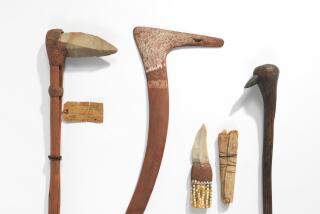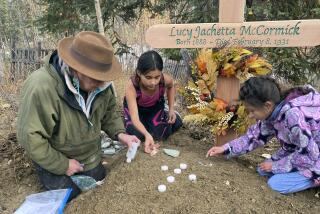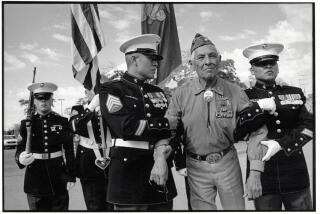A Rich Vein of History
On the hundredth anniversary of its gold rush, Alaska has struck gold once more--this time thanks to a Los Angeles couple.
Caryl and Jack Krug today will donate a treasure trove of rare documents, photographs and Eskimo art collected during the gold rush era to the Alaska State Museum and State Library.
The collection will be accompanied by a heavily researched, 200-page book that traces the unlikely story of how Caryl Krugâs parents came to own the artifacts and offers an unusual take on the famed gold rush.
The book, âOne Dog Short,â is being hailed for its depiction of the development of the frontier town of Nome from the viewpoint of educated entrepreneurs instead of the more familiar tale of strike-it-rich prospectors, Wild West saloons and prostitutes.
Alaskan officials led by Lt. Gov. Fran Ulmer plan to accept the donation this morning in ceremonies scheduled in the capital city of Juneau.
The collection âsheds more light on what life was like during this important period of Alaskaâs history,â Ulmer said. âThe collection is also compelling because the familyâs personal story is contained in the Krugsâ book.â
The Krugs, of Rolling Hills Estates, said they decided to donate the accumulation after waving off offers by several well-known auction houses eager to sell the artwork.
The art includes intricately carved walrus, mammoth and mastodon tusks and what experts describe as the worldâs largest collection of Eskimo billikens--fanciful ivory good-luck figures.
âWe decided we wanted to return them to Alaska. Our son and daughter agreed,â said Caryl Krug, whose parents, William and Neeta Sale, collected the items in the Nome area between 1900 and 1912. âThatâs where these belong.â
William Sale was a businessman who traveled to Alaska to manage a gold mine being operated by his brother. His wife was a concert violinist who met and married him after being marooned there by approaching winter storms during a sailing trip to Alaska.
William Sale went on to become the United States governmentâs deputy recorder in Nome. His young bride became one of the most popular entertainers in the thriving mining town, performing at balls and concerts for a surprisingly refined and appreciative frontier audience.
The Krugsâ research--which drew not only from Saleâs personal records but from a 10-year study of microfilmed Alaskan records and newspapers--suggests that Nomeâs 12,488 turn-of-the-century residents were more social and enlightened than many people think. The townâs present-day population is 4,021.
âThey played basketball, built toboggan runs, raced ice boats and had elaborate parties,â said Jack Krug, an 82-year-old retired oil company manager.
And they had social graces. âI found formal letters written by my father to my mother before they married, asking her to do things like go sleigh-riding with him,â added Caryl Krug, 71.
The Sales purchased Eskimo art directly from the artists, including Alaskaâs most acclaimed native craftsman, Happy Jack Angokwzhuk. They also collected handmade buttons and jewelry, and cribbage boards fashioned from walrus and mastodon tusks, along with scale models of sleds, sailing ships, wolves and seals, and Bering Strait-type kayaks carved from the same ivory.
They proudly displayed their art at home after moving to Seattle, where Caryl was born, and then settling in Los Angeles, where William Sale ran a party supply company before his death in 1955.
Caryl Krug remembers taking the artifacts for granted as a child.
She casually toted pieces of Eskimo ivory worth thousands of dollars to school for show and tell. And she and her brothers and sister routinely gave girlfriends and boyfriends ivory billiken figures as gifts.
âWeâd roll our eyes when our parentsâ friends from the L.A. Sourdough Club [a social organization whose members had spent at least one winter in Alaska] came and everybody would be reminiscing about the old days. Weâd say, âOh no, not Alaska talk again.â â
Oddly enough, no one in the family returned to Alaska until a year after Neeta Saleâs death in 1977 at age 91. The Krugs decided to begin their research project after spotting a photograph of William Sale in a history book displayed at an Alaskan gift shop.
After writing âOne Dog Shortâ--the title refers to William Saleâs 1900 sled trip from Dawson City to Nome, which he had to make with three dogs when he couldnât find a fourth--the artifacts took on new meaning for the Krugs.
âIt was traumaticâ to pack up the 400 carvings and other objects and more than 1,200 family photographs and documents for shipment to Alaska, Caryl Krug acknowledged before leaving Thursday for Juneau.
Alaskan officials were stunned by the Krugsâ artwork donation, whose estimated value is more than $500,000, and by the accompanying documentation--which they say is priceless.
Alaska State Museum curator Bruce Kato said copies of the Krugsâ book, published by the Alaska Department of Education, will be sent to universities and libraries across the state and sold by a Friends of the Library group.
The bookâs explanation of frontier life and of how the artifacts were collected makes the Krugsâ donation âone of the most significantâ collections in Alaska, according to Kato.
Call it one last nugget from Alaskaâs gold rush.
More to Read
Sign up for Essential California
The most important California stories and recommendations in your inbox every morning.
You may occasionally receive promotional content from the Los Angeles Times.











